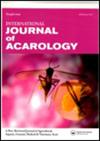三种恙虫(恙虫目:恙虫科)共同寄生在巴西一只家猫身上,包括病原体监测
IF 1
3区 农林科学
Q3 ENTOMOLOGY
引用次数: 0
摘要
摘要恙螨的生态学有许多未知的方面,尽管最近有几项研究涉及该类群的分类学和系统学。在巴西,记录在案的共寄生脊椎动物包括伯南布哥州的负鼠、皮亚伊州的蜥蜴和啮齿动物,以及圣保罗州的啮齿动物。1758年,在南里奥格兰德州南卡夏斯的一只家猫Felis catus Linnaeus(哺乳动物:Felidae)身上采集的Chiggers被送往布坦坦研究所(IBSP)进行鉴定。该物种被鉴定为8个尾根真丝酵母幼虫,2个valida Brennan寄生蜂幼虫,1969年,和2个Ewing真丝酵母属标本,在本文中被描述为巴氏真丝酵母。此外,我们扩增了尾根假丝酵母和巴氏假丝酵母的部分18S rRNA基因序列。然而,扩增立克次体gltA基因片段的尝试没有成功。本研究报告了一只驯养猫科动物与这三个物种的共寄生性,第二个记录是E.tinami,第一个记录是南里奥格兰德州的P.valida,以及E.bassinii n.sp的描述。http://www.zoobank.org/urn:lsid:zoobank.org:act:D0D6EEAB-DDB6-49F0-9651-4AFB96D4D588本文章由计算机程序翻译,如有差异,请以英文原文为准。
Three chigger species (Trombidiformes: Trombiculidae) co-parasitizing a domestic cat in Brazil, including pathogen monitoring
ABSTRACT The ecology of chigger mites has many unknown aspects, even with several recent studies addressing the taxonomy and systematics of this group. In Brazil, the chigger species recorded coparasitizing vertebrates include opossums in the Pernambuco State, lizards and rodents in the Piauí State, and rodents in the São Paulo State. Chiggers collected on a domestic cat, Felis catus Linnaeus, 1758 (Mammalia: Felidae), from Caxias do Sul, Rio Grande do Sul State, were sent to the Acarological Collection of Instituto Butantan (IBSP) to be identified. The species were identified as eight larvae of Eutrombicula tinami, two larvae of Parasecia valida Brennan, 1969, and two specimens of the genus Eutrombicula Ewing, 1938, which have been described here as Eutrombicula bassinii n. sp. Additionally, we amplified partial 18S rRNA gene sequences for E. tinami and E. bassinii n. sp. However, the attempts to amplify fragments of the gltA gene of Rickettsia were unsuccessful. The present study reports the coparasitism in a domesticated feline with these three species, the second record of E. tinami, the first record P. valida to the Rio Grande do Sul State, and the description of E. bassinii n. sp. http://www.zoobank.org/urn:lsid:zoobank.org:act:D0D6EEAB-DDB6-49F0-9651-4AFB96D4D588
求助全文
通过发布文献求助,成功后即可免费获取论文全文。
去求助
来源期刊
CiteScore
2.20
自引率
9.10%
发文量
60
审稿时长
6-12 weeks
期刊介绍:
The International Journal of Acarology has a global readership and publishes original research and review papers on a wide variety of acarological subjects including:
• mite and tick behavior
• biochemistry
• biology
• control
• ecology
• evolution
• morphology
• physiology
• systematics
• taxonomy (single species descriptions are discouraged unless accompanied by additional new information on ecology, biology, systematics, etc.)
All submitted manuscripts are subject to initial appraisal by the Editor. If the English is not of a quality suitable for reviewers, the manuscript will be returned. If found suitable for further consideration, it will be submitted to peer review by independent, anonymous expert referees. All peer review is single blind.

 求助内容:
求助内容: 应助结果提醒方式:
应助结果提醒方式:


